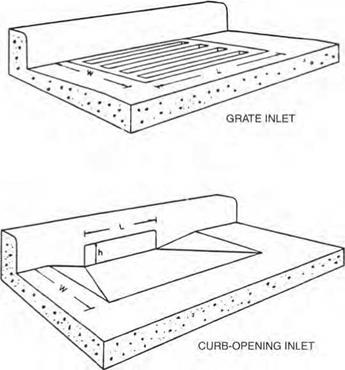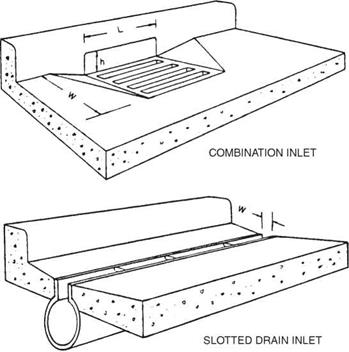Inlet Location and Type
One of the major objectives in the design of the roadway drainage system is to limit the encroachment of the flow to that developed in the roadway drainage guidelines. However, this spread cannot be determined until the inlet is located. After the inlet is located, the drainage area contributing to the flow into that inlet is determined. Discharge based on the rational method is then calculated, and finally the spread is determined based on that discharge and the gutter characteristics. If the spread is found to be too great (leading to possible unsafe conditions) or too small (possibly indicating an inefficient design), the inlet should be relocated and the process repeated. As can be seen, this design is an iterative process. The process is also controlled by surface features that restrict possible location of inlets, such as streets, driveways, and utilities.
There are also areas where inlets are nearly always required. These include sag points, points of superelevation reversal, street intersections, and at bridges. Where an inlet is required in the vicinity of a driveway, it should always be located upstream of the driveway. If it is located downstream, the driveway may affect the flow and cause a significant portion to bypass the inlet.
Finally, the type and size of the inlet have a direct affect on location and spacing. Similarly, designing for greater spread and allowing some bypass of the upstream inlets to occur with the residual being intercepted by those farther downstream (carryover flow) will result in fewer inlets.
The basic types of inlets are the curb-opening inlet and the grate inlet, as shown in Fig. 5.7. Two other types frequently used are the slotted drain inlet and the combination inlet (grate plus curb opening) shown in Fig. 5.8.
Curb-opening inlets, which have the drainage opening in the face of the curb, are very durable and are comparatively free from blockage by debris. This type generally relies heavily on the bordering depression to be effective at intercepting the water flow and is relatively inefficient when located in an on-grade situation. It is probably the most efficient inlet type at sag points because of its tendency to remain free of clogging by debris and its large, hydraulically efficient opening. In addition, this type of inlet opening offers little interference to vehicular traffic, pedestrians, or bicyclists. For curb-opening inlets on continuous grades, a window length that permits approximately 15 percent bypass is considered optimum.
The length of the opening required for total interception of the gutter flow can be determined by the following equation:
|
FIGURE 5.7 Perspective views of grate inlet and curb-opening inlet. (From Urban Drainage Design Manual, HEC 22, FHWA, with permission) |
|
FIGURE 5.8 Perspective views of combination and slotted drain inlets. (From Urban Drainage Design Manual, HEC 22, FHWA, with permission) |
L = KQ0A2S03(nSX)-06 (5.20)
where Lt = length of curb opening for total interception of flow, ft (m)
Q = discharge, ft3/s (m3/s)
S = longitudinal slope of gutter n = Manning’s roughness coefficient SX = transverse slope of gutter K = 0.6 for U. S. Customary units (0.817 for SI units)
Where there is a depression, the equivalent transverse slope Se must be determined and used for SX (See Urban Drainage Design Manual, HEC 22, FHWA, for a complete discussion of this and flow at sag points.)
Grate inlets come in a variety of shapes and sizes and are efficient where debris is not a problem. However, most inlets are subject to varying amounts of debris, and the selection of grate inlets, especially those located at sag points, must take this possibility into account.
For greatest hydraulic efficiency, grate inlets should be oriented with grate bars parallel to the surface flow. However, grate bars oriented parallel with traffic can cause problems where bicycles are present, and specifically designed “bicycle-proof’ grates with additional transverse bars should be used. Other factors influencing the hydraulic capacity of this type of inlet include the longitudinal and cross-slope of the gutter, the width and length of the gutter, and the size and shape of the bars. The grate inlet will intercept all of the flow that passes over the top of the grate as long as the grate is long enough. In addition, a portion of the side flow, or the flow that is located above the grate toward the roadway centerline, will be intercepted. The amount of the intercepted side flow depends upon the velocity of the flow, the length of the inlet, and the cross-slope of the gutter.
Combination grates—generally, curb-opening and grate inlets—are desirable at sag points. The curb opening will generally keep the inlet from clogging. At grade locations, however, the efficiency of the combination inlet approaches that of the grate inlet.
Slotted drains can provide continuous interception of the flow when used on grades. However, because of the possibility of clogging, they should be used only in combination with other types of inlets at sag points. Slotted drains are also useful to supplement the existing drainage system where the roadway needs to be widened.
Inlets at grade sags deserve additional deliberation, since any blockage of the inlet will typically lead to flooding. Typical design considerations are to provide additional inlets or base the design on a relatively high assumption of debris blockage.








Leave a reply